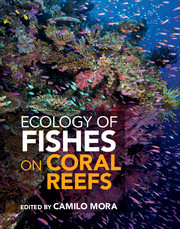Book contents
- Frontmatter
- Contents
- Preface
- Foreword
- List of contributors
- PART I BASIC ECOLOGY
- PART II PATTERNS AND PROCESSES
- PART III HUMAN FINGERPRINTS
- PART IV CONSERVATION
- PART V DEBATES AND PARADIGM SHIFTS
- 23 Is dispersal of larval reef fishes passive?
- 24 Density dependence and independence and the population dynamics of coral reef fishes
- 25 Equilibrial versus non-equilibrial dynamics in coral reef fishes
- 26 Cryptic density dependence: integrating supply-side ecology with population regulation
- 27 Priority effects
- 28 Inverted trophic pyramids
- 29 Shifting baselines in coral reef fishes
- 30 Pluralism explains diversity in the Coral Triangle
- 31 Reef fish biogeographical regions
- 32 Size and sex change
- 33 Quantifying reef fishes: bias in observational approaches
- 34 Seascape ecology of fishes on coral reefs
- 35 The future for coral reef fishes
- 36 Perpetual struggle for conservation in a crowded world and the needed paradigm shift for easing ultimate burdens
- References
- Index
34 - Seascape ecology of fishes on coral reefs
from PART V - DEBATES AND PARADIGM SHIFTS
Published online by Cambridge University Press: 05 May 2015
- Frontmatter
- Contents
- Preface
- Foreword
- List of contributors
- PART I BASIC ECOLOGY
- PART II PATTERNS AND PROCESSES
- PART III HUMAN FINGERPRINTS
- PART IV CONSERVATION
- PART V DEBATES AND PARADIGM SHIFTS
- 23 Is dispersal of larval reef fishes passive?
- 24 Density dependence and independence and the population dynamics of coral reef fishes
- 25 Equilibrial versus non-equilibrial dynamics in coral reef fishes
- 26 Cryptic density dependence: integrating supply-side ecology with population regulation
- 27 Priority effects
- 28 Inverted trophic pyramids
- 29 Shifting baselines in coral reef fishes
- 30 Pluralism explains diversity in the Coral Triangle
- 31 Reef fish biogeographical regions
- 32 Size and sex change
- 33 Quantifying reef fishes: bias in observational approaches
- 34 Seascape ecology of fishes on coral reefs
- 35 The future for coral reef fishes
- 36 Perpetual struggle for conservation in a crowded world and the needed paradigm shift for easing ultimate burdens
- References
- Index
Summary
Ecological study of coral reef fishes is shifting from a reef patch-centric approach to a broader-scale seascape perspective using concepts and techniques from landscape ecology. This change has occurred in response to increasing evidence that many “reef” fishes move among multiple reef patches and also connect different patch types, such as seagrasses and mangroves, through multi-habitat movements. As such, the spatial distribution of patches across the seascape is ecologically relevant. Seascape ecology, the marine counterpart of terrestrial landscape ecology, is concerned with the causes and ecological consequences of spatial patterning in the marine environment. It draws on concepts and analytical techniques from terrestrial landscape ecology supported by advances in remote sensing and spatial statistics. In the past decade, seascape ecologists have quantified effects on reef fish populations and critical ecological processes from variation in reef geometry, such as the spatial arrangement of patches and the three-dimensional morphology of seafloor terrains. This chapter provides a rationale for adopting a seascape ecology perspective for the ecological study of fishes on coral reefs. It describes key concepts central to the implementation of seascape studies, such as how seafloor spatial structure is represented, the ecological significance of mosaics and terrains, and the importance of connectivity and corridors in ecology and marine ecosystem-based management. Lastly, we offer a selection of priority research themes to help guide future research.
Studies of reef fish movements (home range, ontogenetic shifts, and spawning migrations) have shown that many fish move across multiple patches of coral reef and also spend considerable time using non-reef patch types (e.g. seagrasses, mangroves, and macroalgal beds) [635,1111,1824]. Not all species are multi-habitat users, but even reef “residents” may move among patches of coral reef to forage, shelter, spawn, or relocate their home range [65,1841] (Figure 34.1). As such, coral reefs exist as structurally complex patches that are ecologically connected, directly and indirectly, to a broader mosaic of different patch types [993,1870,1924].
- Type
- Chapter
- Information
- Ecology of Fishes on Coral Reefs , pp. 274 - 282Publisher: Cambridge University PressPrint publication year: 2015
- 22
- Cited by



